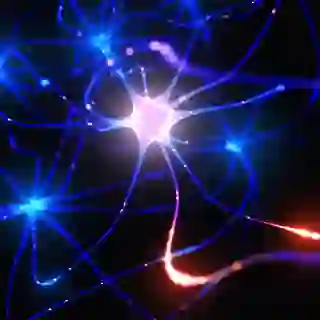Everything You Need to Know About Chronic Migraine Auras

If you’re into woo-woo kind of stuff, you’re probably familiar with the word aura, which in the spiritual realm describes an energy field that surrounds all living things. If you go for an “aura reading,” you’ll be shown a light-sensitive photo with different colors and patterns surrounding you, signifying different aspects of your personality. Ironically, that version of aura is not so far away from what 20% of people with chronic migraine experience, according to the Mayo Clinic in Rochester, MN—lights and patterns (minus the New Age-y interpretation).

What Does an Aura Look Like?
In the case of migraine, auras are neurological symptoms, also referred to as visual disturbances that collectively serve as warning signs that a migraine attack is coming on, says Merle Diamond, M.D., president and medical director of the Diamond Headache Clinic in Chicago and spokesperson for the National Headache Foundation. Auras can appear as sparks, bright dots, and zig zags in front of your eyes (none of which are actually there). Sometimes, they take more concrete shapes: The best-known visual aura is called a fortification spectrum, because its pattern resembles the walls of a medieval fort.

How Long Do Auras Last?
In adults, auras typically involve only half the visual field, whereas in children these flashes of light may be randomly dispersed. Generally, auras tend to come on about 10 minutes to one hour before the migraine itself, Dr. Diamond says. They commonly last 15 to 20 minutes, though they can linger for up to 60 minutes. However, if your aura symptoms last longer than an hour or are accompanied by temporary vision loss, speech or language difficulty, or muscle weakness on one side of your body, seek medical attention immediately.

What Causes an Aura?
Researchers believe auras are caused by something called a cortical spreading depression, or slow-moving wave of electrical activity across the cortex of the brain (the gray matter), says Lisa Smith, a spokesperson for the Association of Migraine Disorders in North Kingstown, RI. “These waves can disrupt vision and other senses for a short period of time,” she says. “When cortical spreading depression hits the visual cortex, people experience visual distortions.” Although auras usually aren’t painful or dangerous by themselves, they can make activities like driving difficult.

Auras Are Different for Everyone
Auras are not one size fits all, meaning anyone who gets an aura may experience it differently. And they don’t necessarily occur before every migraine attack, Dr. Diamond says. Auras can also be experienced as sensory or motor disturbances, which may include tingling, numbness, and weakness, or as a dysphasic aura, which causes verbal and language symptoms like mumbling or slurred speech. According to the Cleveland Clinic in Ohio, among people who experience auras, 90% to 99% develop visual auras, 36% develop sensory auras, and 10% of people develop dysphasic auras.

Understanding Sensory Disturbance and Dysphasic Auras
“When that cortical spreading depression affects other parts of the cortex, some people experience temporary numbness or paralysis, or may feel clumsy,” Smith says. Others might have temporary aphasia, or an inability to understand and use language. For example, when you suddenly can’t find the words for simple things you say all the time, that is a kind of aphasia, Smith says. Some people may even experience phantom smells—i.e., smelling something that isn’t there. “These symptoms may be an indicator that a migraine attack is coming,” Smith says.

Triggers for Chronic Migraine Auras
Since auras are one of many chronic migraine symptoms, they are triggered by the same things that bring on all migraine attacks—things like bright lights, stress, sleep disturbances, your menstrual cycle, certain foods, or medications. (Scientists are still trying to understand the reasons these things can trigger head pain.) While auras may be a bit uncomfortable, they aren’t dangerous. But they can mimic the symptoms of a stroke, so it’s important to see your doctor who can rule out other conditions by performing an eye exam, a CT scan of your head, or an MRI.

How Is an Aura Diagnosed?
A migraine with aura is diagnosed when there have been at least two attacks with any three of the following features: One or more aura symptoms like seeing flashing lights or dots in your vision, visual disturbances that last longer than 4 minutes but less than 60 minutes, and a migraine attack that occurs less than 60 minutes after an aura. Generally, the head pain that follows an aura is described as throbbing or pulsing, though the side of the head affected during each migraine episode can change.

Treatments for Auras
Just like treating chronic migraine itself, treating an aura is directed at relieving head pain. Medications used to alleviate migraine pain are most effective when taken at the first sign of a migraine episode—so as soon as an aura comes on, it’s best to seek treatment. Keep in mind that while a migraine aura usually comes before the attack itself, it can also occur during the migraine episode. And, to make matters more complicated, a migraine aura can also occur without a headache that follows.

How to Cope With Auras
When aura symptoms strike, head to the nearest dark and quiet room, get comfy, and close your eyes. Placing a cool compress or an icepack wrapped in a towel on your forehead can help soothe any discomfort and possible reduce subsequent migraine pain. To lower your odds of an aura happening in the first place, it’s important to maintain a consistent routine. “A migraine brain likes things to be as regular as possible,” Dr. Diamond says. Sleep, eat, hydrate, and exercise on a consistent schedule to help keep symptoms at bay.
All About Auras: The Mayo Clinic. (2021.) “Migraine Aura.” https://www.mayoclinic.org/diseases-conditions/migraine-with-aura/multimedia/migraine-aura/vid-20084707
Understanding Auras: Cleveland Clinic. (2021.) “Migraine Aura.” https://my.clevelandclinic.org/health/diseases/22131-migraine-aura
Auras A to Z: Stat Pearls. (2021). “Migraine with Aura.” https://www.ncbi.nlm.nih.gov/books/NBK554611/